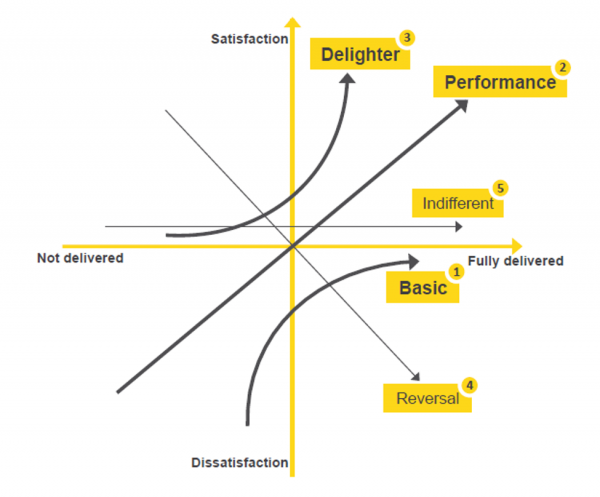Do you remember when you had to lock each individual car door manually? Then came the revolution of ‘central locking’. After that ‘remote central locking’. They used to be a feature or even an optional extra. Today though, they’re an expected standard on a new car. Our expectations and needs have evolved as the product itself has.
Japan’s Dr. Kano developed a model in 1984 that can help any team or organisation get a better understanding of Customer Requirements and their impact on Customer Satisfaction. He classified them into five categories:
1. Basic (Must Have) – If this attribute isn’t fulfilled then customers will be dissatisfied. However, fulfilment of it doesn’t increase satisfaction. E.g. having a bed in a hotel room
2. Performance (One Dimensional) – Customers will be satisfied if this attribute is there and dissatisfied if it isn’t. E.g. mpg performance from a car
3. Attractive (Delighter) – Customers will be delighted when this attribute is provided, but if it’s not there it doesn’t cause dissatisfaction. E.g. That unexpected free upgrade on a long haul flight
4. Reversal – Adding something or increasing complexity can create increasing dissatisfaction. E.g. too much choice in a restaurant
5. Indifferent – The level of customer satisfaction will not be affected by this factor. E.g. the size of a logo on a take away coffee cup
(See diagram at bottom of page)
Understanding your customers is key and we are all different. What delights one, may in fact dissatisfy another. Some of us love to have the latest technology on a mobile phone, for others it’s a hindrance to just being able to make a simple phone call.
Getting the basics right is a must. Beyond that we can build satisfaction levels and even set ourselves apart from competitors by having a clear understanding of what makes our customers tick. This is an iterative process and we need to keep listening for fear of being the car manufacturer still classing power steering, electric windows and remote central locking as ‘optional extras’.
For more information about Kano’s model and how it could apply to your organisation, contact Sarah Jones or Steve Palmer on enquiry@w-l-p.co.uk.

